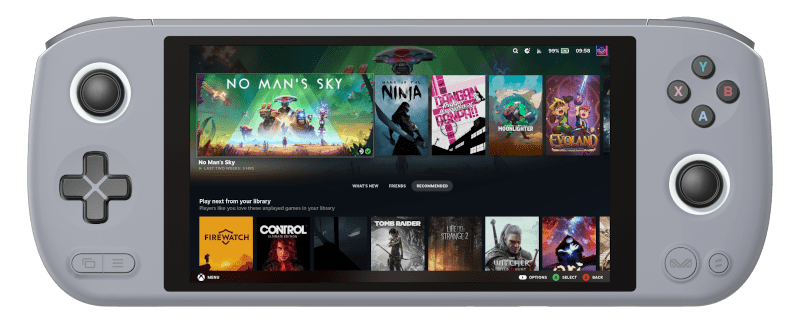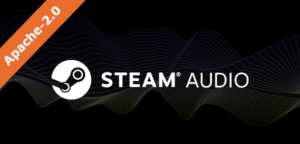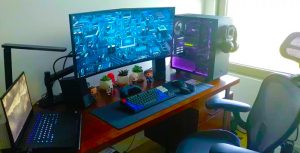What do you do when you own a handheld gaming device that you really wish was a Steam Deck? You install SteamFork on it, that’s what you do.

Raise your hand if you remember Fuduntu.
For those who don’t remember, Fuduntu was a distro that was first released 2010. It’s founder and lead developer, Andrew Wyatt, started it to get something that looked like his distro of choice, Fedora, to run well on an underpowered Asus Eee PC netbook he’d bought. Although the distro was pretty popular with folks looking for a full featured distro that would work well on older or underpowered hardware, he shut the project down in 2013 after trolls who had joined the project’s community made working on it no longer enjoyable.
If you’re wondering why I would ask about a Linux distribution that ceased to exist more than a decade ago, it’s because Wyatt is back with an all new distro.
The distro is called SteamFork, which you might guess is a fork of SteamOS, Valve’s operating system for Steam Deck as well as its earlier Steam Machines. From that you might also guess that it’s not designed to run on PCs or laptops, but on handheld devices.
Just as he did with Fuduntu, Wyatt started this project to scratch a personal itch. This time he wanted to have the Steam Deck experience even when using a device that wasn’t built by Valve.
“I started it as just another one of those projects where I just wanted to do something for myself,” Wyatt told me in an interview. “I have a Steam Deck and I have these other devices, and they don’t work the same. Some of them are in Windows, and I’m not a Windows person, so I needed to fix that.”
Not wanting to deal with Windows is something we at FOSS Force completely understand. But there are alternative Linux distros for gaming, like RetroArch, that wouldn’t require putting together a completely new distro. The problem, according to Wyatt, is that none of them offer the full Steam Deck experience.
“The options out there were okay, but I just wanted it to be like my Steam Deck and so I just started working on it and here we are,” he said.
The initial device that he worked to get running on SteamFork was an Ayaneo Flip KB. This is somewhat ironic since unlike the underpowered Eee PC platform that inspired Fuduntu, the Ayaneo handheld is no slouch, and might even be considered by some to be superior to the Steam Deck.
“Ayaneo is a company that kind of specializes in AMD- and Arm-based hand held gaming consoles,” Wyatt said. “They have a lot of android consoles which I don’t really have anything to do with, but their AMD64 stuff is pretty bleeding edge. Like this one has a 7840u, so it’s got a nice APU in it, 32 gigs RAM and 2 TB NVMe storage, so it’s actually faster than my Steam Deck by a lot, but of course the battery life is not nearly as good.”
Another thing that Wyatt said he likes about the device is that it closes, “So I can put it in the glove box and take it everywhere I go. That’s one of the main draws to it for me.”
“It’s well supported already,” he added. “It’s been supported since the beginning and it looks just like any other system with SteamOS on it. I’m logged into a game right now so I can’t really show the interface, but it looks and feels just like a Steam Deck. If if I was doing a screen share with you, you probably wouldn’t know the difference.”
Open Source the Old Fashioned Way
At this point, I liked everything I’d heard about how SteamFork got started, and I ended up liking what I was about to learn about SteamFork’s organic development “team” even more. Even though I’m famously not a gamer (Minesweeper and an old MS-DOS pinball game I purchased on a floppy were about as far as I got into gaming) everything I was hearing about this distro reminded me of earlier days when computing was much more fun, much more adventurous, and seemed to have much more positive potential than it does now.
With open source now being largely overrun by enterprise users it’s hard to remember that at the turn of the century most open source projects were similar to what Wyatt is doing now: developers writing code for themselves, then giving it away because it might be useful to other computer users. Actually, that mindset started before the concept of open source and even the internet existed. I remember frequent visits in the early 1990s to the local Egghead Software store, where for a couple of bucks I could buy a floppy disk loaded with nifty MS-DOS shareware programs, like the pinball game that kept my other half entertained for hours.
These days, most home computer user are using phones instead of PCs as their goto machines, and aren’t really much interested in how software works under the hood. Part of this is because Android and iOS hide the inner workings of devices from users, but perhaps it’s more because phones made easy-to-use computers available to users who never whould have been interested in owning a PC or learning how computer sausage is made back in the old days.
It’s just the opposite with SteamFork where almost by design somewhere around 100% of the people who contribute to the project are users.
“A few people have come along and added support for their own devices, and then they stick around, and participate in our Discord,” Wyatt said.
All, or nearly all, of the contributions made to the project fall into the category that got both Fuduntu and SteamFork going to begin with: developers scratching their own itches. In other words, they contribute go get support for an unsupported device that they own.
“We only support the hardware that we own,” he said. “If you have a piece of hardware that I don’t, I won’t support it, I need you to support it, and I’ve made that process as simple as possible.”
That last bit about making it as simple as possible might be key to whatever success Wyatt is having when it comes to expanding the number of devices the distro supports.
“The process is all documented on how to get started and add your own support for your device,” he said “If it’s easy, you just run a GUI and check a couple of check boxes, and it generates everything for you. You pull request it to our repo and then congratulations, your device is supported. Sometimes it’s trickier. Some of these devices have rotated panels, so you have to add a kernel port to rotate the panel correctly, and things like that.”
As with just about any software project, online help is just a click away, in this case on the project’s Discord channel.
As a Linux distro that’s not designed to work on a PC or laptop, and which can’t even be made to run on handhelds beyond a certain age, SteamFork is not on the road to becoming the next Linux Mint — or even the next Fuduntu.
“It’s small and it’ll probably stay small, and that’s OK,” Wyatt said. “Whenever Steam or Valve finally releases SteamOS for everything else I’ll probably sunset it and it won’t need to exist anymore. That’s perfectly fine too.”
Christine Hall has been a journalist since 1971. In 2001, she began writing a weekly consumer computer column and started covering Linux and FOSS in 2002 after making the switch to GNU/Linux. Follow her on Twitter: @BrideOfLinux








